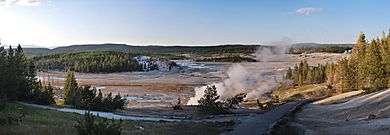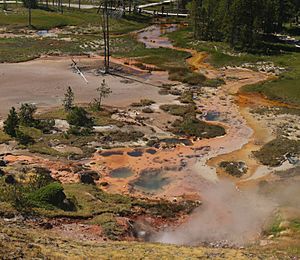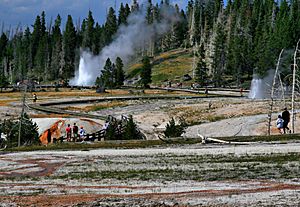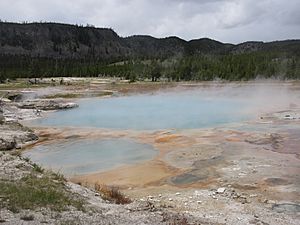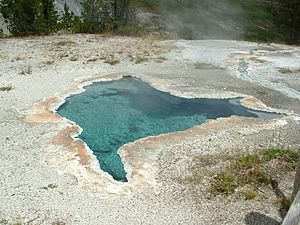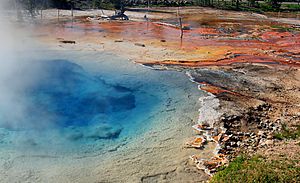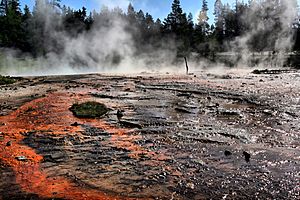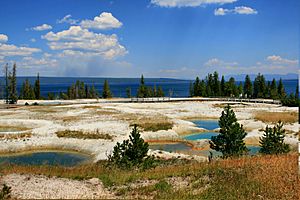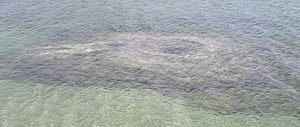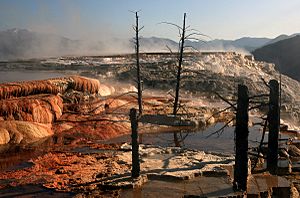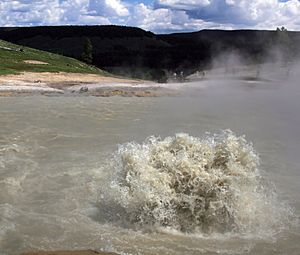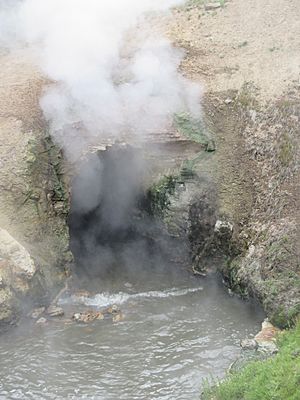Geothermal areas of Yellowstone facts for kids
The geothermal areas of Yellowstone are amazing places in Yellowstone National Park where you can see the Earth's heat in action! These areas have many cool features like geysers, hot springs, mud pots, and steam vents called fumaroles. Yellowstone has about 10,000 of these thermal features. In fact, over 1,200 geysers have erupted here, and about 465 are active each year.
You can find these features in nine main areas called geyser basins. Even though famous geysers like Old Faithful are big, most geysers in Yellowstone are small, erupting only a foot or two high. All this hot water comes from a huge, ancient caldera (a collapsed volcano) deep underground. Many of these hot spots build up mineral deposits like sinter or travertine around them, making unique shapes.
These geyser basins are located where rain and melted snow can soak into the ground. This water then gets superheated by the hot rock deep below, thanks to the Yellowstone hotspot. Finally, it bursts back out as geysers, hot springs, and fumaroles. Most large geothermal areas are in flat valleys between old lava flows. Smaller areas appear where cracks in the Earth's surface, called fault lines, reach the top.
Because Yellowstone is so high up, water boils at a lower temperature, around 199°F (93°C). But when water is trapped deep underground, it can get much hotter. When the pressure builds up, it can erupt as hot water and steam, sometimes shooting up to 390 feet (120 m) high! This is like Steamboat Geyser, the world's tallest geyser. The water coming out is super hot, about 204°F (95.5°C). It cools quickly in the air, but it's still very important to stay on the boardwalks and marked trails. This keeps everyone safe from the hot water.
Long ago, Native Americans found artifacts at places like Mammoth Hot Springs. Some stories say they used the hot water for bathing and cooking. In the 1800s, explorers like John Colter and Joseph Meek described these bubbling, steaming lands. Jim Bridger, a famous trapper, even called it "the place where Hell bubbled up" because of the intense heat and steam!
Contents
How Yellowstone's Hot Features Work
The amazing heat that powers Yellowstone's geothermal activity comes from salty water, called brine, located about 1.5 to 3 miles (2.4 to 4.8 km) below the surface. At this depth, the brine gets super hot, over 400°F (204°C), but it stays liquid because of the huge pressure, like a giant pressure cooker.
This churning hot brine transfers its heat to fresh groundwater above it. The rocks under Yellowstone are full of cracks and holes, which helps the water move around. As hot water flows through these rocks, it dissolves a mineral called silica. This silica later gets deposited back onto the cracks, making the system almost watertight. At the surface, silica forms deposits like geyserite or sinter, creating the unique shapes of geyser cones and hot springs.
Types of Geothermal Features
Yellowstone has at least five main types of geothermal features:
- Fumaroles: These are steam vents and are the hottest features in the park. They have so little water that it all turns into steam before reaching the surface. At places like Roaring Mountain, you can hear loud hissing sounds from the steam and gases.
- Geysers: Geysers, like Old Faithful, are special hot springs that erupt hot water and steam from time to time. Water deep underground gets superheated but can't boil because of the pressure. As it rises, steam bubbles form and expand. Eventually, these bubbles push the water above them, causing an eruption. The water shoots out, and the pressure drops, ending the eruption until it builds up again.
- Hot springs: Hot springs, such as Grand Prismatic Spring, are the most common features. Their underground plumbing is open, allowing hot water to rise, cool, and sink, creating a constant circulation. This prevents the water from building up enough pressure to erupt. Many hot springs create warm streams.
- Mudpots: Mudpots, like Fountain Paint Pots, are acidic hot springs with limited water. Tiny living things (microorganisms) use gases from deep in the Earth, like hydrogen sulfide (which smells like rotten eggs). They turn this gas into sulfuric acid, which breaks down rock into clay, creating bubbling mud.
- Travertine terraces: These are found at Mammoth Hot Springs. They form from limestone, a rock made of calcium carbonate. Hot water flows through the limestone, picking up lots of dissolved carbonate. When the water reaches the surface, carbon dioxide gas is released, and the calcium carbonate is deposited as travertine, a chalky white rock. These terraces change quickly as new deposits form.
Exploring Yellowstone's Geyser Basins
Norris Geyser Basin
The Norris Geyser Basin is the hottest geyser basin in Yellowstone. It's located where three major faults (cracks in the Earth's crust) meet. This makes it very active and hot. Unlike most other geyser basins in the park, the water at Norris is acidic, not alkaline. This difference in water chemistry allows different types of bacteria to grow, creating unique colors in the water and surrounding areas.
Norris Geyser Basin has three main parts: Porcelain Basin, Back Basin, and One Hundred Springs Plain. The tallest active geyser in the world, Steamboat Geyser, is here. While Old Faithful erupts often and predictably, Steamboat's major eruptions are rare and can be years apart. When it does erupt, it shoots water over 300 feet (90 m) into the air! Between major eruptions, Steamboat still has smaller eruptions, about 40 feet (12 m) high.
Sometimes, Norris Geyser Basin experiences big changes for a few weeks. Water levels, temperatures, colors, and eruption patterns can all shift. For example, in 1989, Porkchop Geyser exploded, throwing rocks over 200 feet (60 m) because it got clogged with minerals.
North of Norris, you'll find Roaring Mountain, a large, acidic area with many fumaroles. You can see the steam best in the cool mornings or evenings. Artists' Paintpots is another small area nearby with colorful hot springs and two large mudpots.
Upper Geyser Basin
South of Norris is the Upper Geyser Basin, which has the most geothermal features in the park. This is where you'll find the most famous geyser, Old Faithful. Besides Old Faithful, there are four other large geysers that erupt predictably: Castle Geyser, Grand Geyser, Daisy Geyser, and Riverside Geyser. Biscuit Basin and Black Sand Basin are also part of this area.
The hills around Old Faithful are made of old lava flows. These flows happened long after a huge volcanic eruption 640,000 years ago. They moved across the land like thick dough because they had a lot of silica.
Evidence of glaciers is everywhere here, and they are key to why geysers exist. Glacial deposits under the geyser basins hold the water needed for eruptions. Many landforms, like the Porcupine Hills, are made of glacial gravel, reminding us that this area was covered in ice between 70,000 and 14,000 years ago.
Midway Geyser Basin
The Midway Geyser Basin is much smaller than other basins along the Firehole River. But despite its size, it has two huge features. One is the Excelsior Geyser, which is about 200 by 300 feet (61 by 91 m) wide and pours over 4,000 gallons (15,000 L) of water per minute into the Firehole River. The other is the largest hot spring in Yellowstone, the Grand Prismatic Spring, which is 370 feet (113 m) wide and 121 feet (37 m) deep. You can also find Turquoise Pool and Opal Pool here.
Lower Geyser Basin
Further north is the Lower Geyser Basin, the largest geyser basin by area, covering about 11 square miles (28 square km). Because it's so big, its geothermal features are more spread out. This basin includes Fountain Paint Pots, which are mud pots – hot springs with boiling mud instead of water. The mud forms because the water is very acidic, dissolving nearby minerals into a thick, usually gray, mud. Other features include Firehole Spring, Celestine Pool, and many fumaroles.
Geysers in Lower Geyser Basin include Great Fountain Geyser, whose eruptions can reach 100 to 200 feet (30 to 61 m) high, with water cascading down its terraces. There's also the Fountain group of Geysers, including Clepsydra Geyser which erupts almost constantly, and the Pink Cone group of geysers.
West Thumb Geyser Basin
The West Thumb Geyser Basin is the largest geyser basin on the shores of Yellowstone Lake. The heat source for these features is thought to be quite close to the surface, only about 10,000 feet (3,000 m) down. West Thumb is actually a smaller caldera (a collapsed volcano) inside the much larger Yellowstone Caldera. It formed about 162,000 years ago when a magma chamber bulged up and then collapsed, creating a basin that later filled with water from Yellowstone Lake. This created the perfect conditions for the West Thumb Geyser Basin.
The thermal features here are not just on the lake shore but also extend under the lake's surface. You can sometimes see them as slick spots or slight bulges in the water during summer. In winter, when the lake freezes thick, these underwater features create melt holes in the ice.
One of the most famous features at West Thumb is Fishing Cone, a geyser on the lake shore. Early visitors used to fish in the lake and then cook their catch right in the geyser! However, this is now against the rules because it's very dangerous. One fisherman was badly burned in 1921.
Backcountry Geyser Basins
The Gibbon, Heart Lake, Lone Star, and Shoshone Geyser Basins are located in more remote parts of the park. Some require hiking several miles to reach. These areas generally don't have boardwalks or other safety features like the more developed areas. It's very important to stay on marked trails, especially in these remote areas, as falling into a hot spring can be very dangerous.
The Shoshone Geyser Basin, which you can reach by hiking or boat, has one of the highest concentrations of geysers in the world – over 80 in a small area. Hot springs and mudpots are also common between the geyser basin and Shoshone Lake.
Mammoth Hot Springs
Mammoth Hot Springs is a large area of hot springs on a hill made of travertine. It's located near Fort Yellowstone. Over thousands of years, hot water from the springs has cooled and deposited calcium carbonate, creating these unique terraces. Even though these springs are outside the main Yellowstone Caldera, their heat comes from the same underground magma system that powers other Yellowstone geothermal areas.
Mud Volcano and Sulfur Cauldron
The thermal features at Mud Volcano and Sulfur Cauldron are mostly mud pots and fumaroles. This area has less water, so it boils away quickly, creating steam vents. The vapors here are rich in sulfuric acid, which breaks down the rock into clay. Since no water washes away the acid or clay, it forms sticky mud pots. Hydrogen sulfide gas from deep underground mixes with water, and tiny bacteria turn it into sulfuric acid. This acid dissolves the soil, creating pools and cones of bubbling mud. Steam, carbon dioxide, and other gases also explode through the mud layers.
In 1978, shallow earthquakes related to Yellowstone's volcanic activity caused soil temperatures here to rise to almost 200°F (93°C). An area once covered with green grass and trees became a barren landscape of fallen trees, known as "the cooking hillside."
Images for kids


